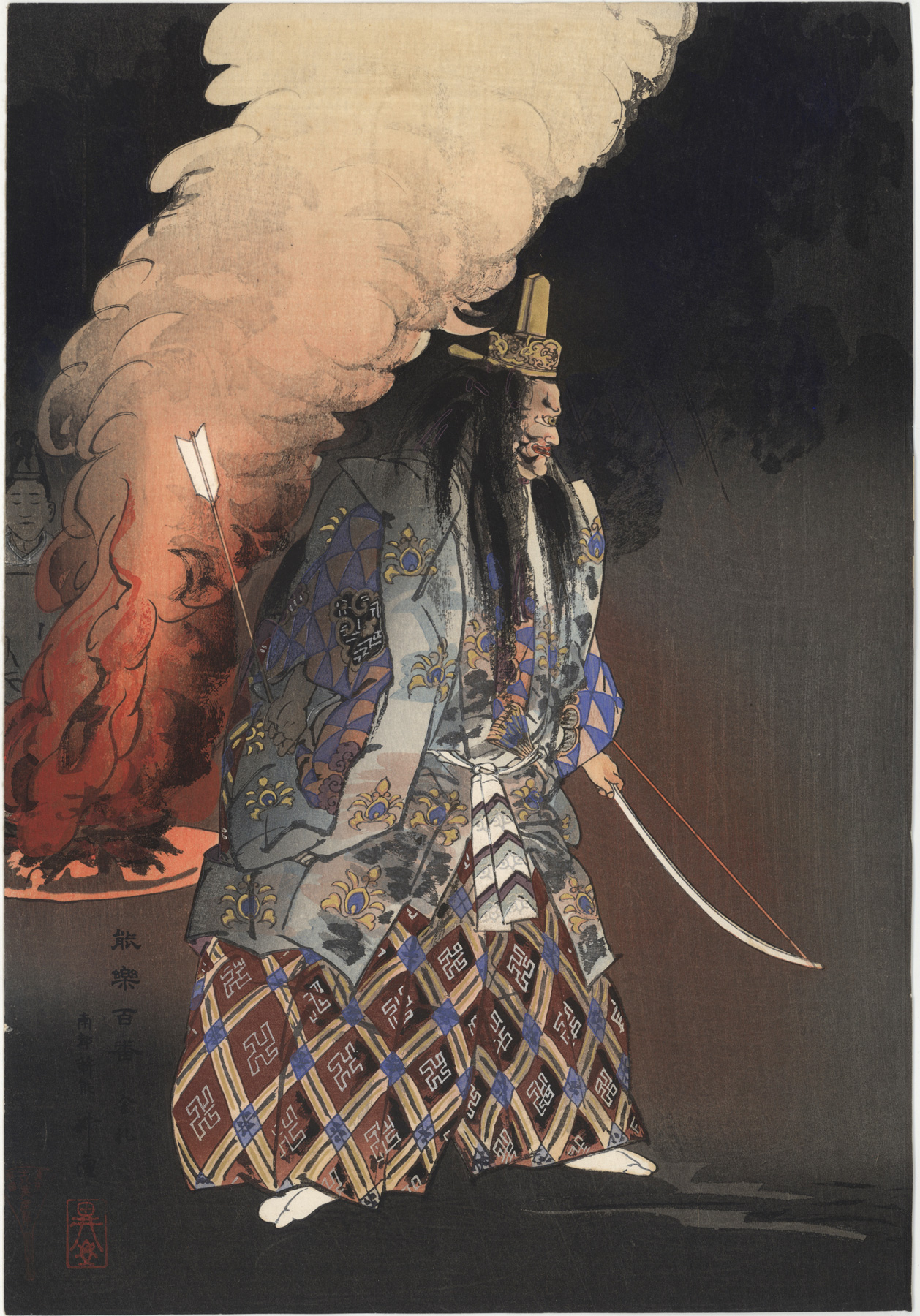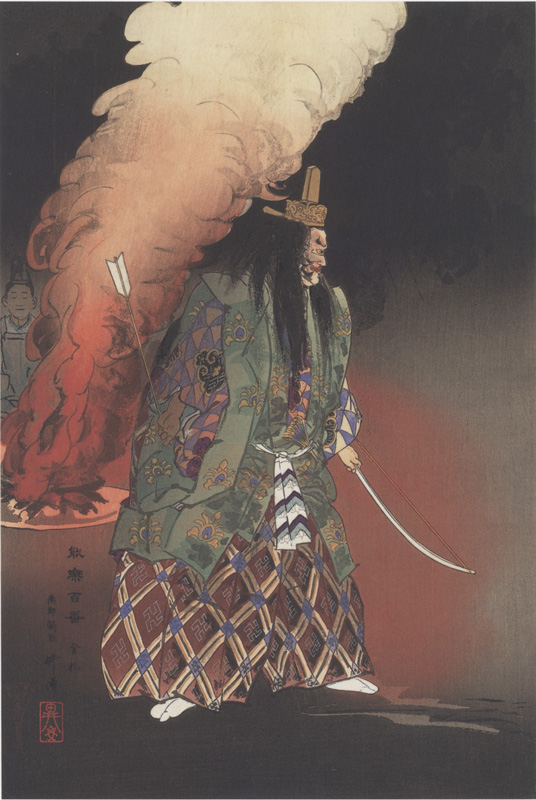About This Print
One of 120 prints issued as part of the series Nōgaku hyakuban (One Hundred Prints of Noh). The print depicts the god Amatsu Futodama carrying a bow and arrow with which to subdue demons and ensure the peace of the land.The pyre in the background "suggests that this is an outdoor performance called takigi nō. The custom has its origins in the practice of burning sacred firewood (takigi), a special ceremony held at the Kofuku Temple (Kōfukuji), one of the most ancient Buddhist temples in Nara."1
This print was originally released by the publisher Matsuki Heikichi in the fourteenth installment of prints in this series. This series' prints were offered in monthly installments consisting of three prints packaged in an envelope with additional descriptive information.2
For other depictions of this play by the artist see Nōga taikan, Kinsatsu.
Variant Printing
It is unknown how many times the prints in this series were re-printed, but variations (usually use of different colors on parts of the actor's costume) between prints of the same play suggest there were at least two separate printings. It may be as suggested by Claus-Peter Schulz in his October, 2000 article appearing in Andon 67, that "there might have also been a later second issue" of these prints by the publisher that were assembled by the publisher for sale at the completion of the series.
1 The Beauty of Silence: Nō and Nature Prints by Tsukioka Kōgyo (1869-1927), Robert Schaap & J. Thomas Rimer, Hotei Publishing, 2010, p. 93.
2 “The series Nogaku hyakuban (100 No plays) by Tsukioka Kogyo (1869-1927),” Claus-Peter Schulz, Andon 67, Society for Japanese Arts, p. 28.
The Play - Kinsatsu
The Play - Kinsatsu
Source: A Guide to No, P.G. O'Neill, Hinoki Shoten, 1929, p. 77-78.
By Zeami
Third group
All schools
Characters
Act 1: waki - an Imperial envoy; waki-tsure - two retainers; shite - an old man; kyōgen - a local person
Act 2: nochi-shite - the god Amatsu Futodama
An Imperial envoy goes to the village of Fushimi in Yamashiro Province in connection with a new shrine being built there by the Emperor Kammu. While talking with an old man whom he meets there, a tablet with gold writing on it falls from the sky. Taking it up, the envoy read that the god to whom it belongs promises constant protection to the land. The old man then takes the tablet and disappears, revealing as he does so that he is the god, Amatsu Futodama. He then appears in his true form, carrying a bow and arrow with which to subdue demons and ensure the peace of the land.
Print Details
| IHL Catalog | #2215 |
| Title | Kinsatsu 金札 (The Golden Tablet) |
| Series | Nōgaku hyakuban 能楽百番 (One Hundred Prints of Noh or One Hundred Noh Plays) |
| Artist | Tsukioka Kōgyo (1869-1927) |
| Signature |  |
| Seal | Kōgyo 耕漁 seal (shown above), seal no. 49, p. 171 in The Beauty of Silence: Nō and Nature Prints by Tsukioka Kōgyo (1869-1927), Robert Schaap & J. Thomas Rimer, Hotei Publishing, 2010. |
| Date | August 1923 |
| Edition | unknown |
| Publisher |  松木平吉 (大黒屋) seal reading: 東京両国 大黒屋 発行 published by Daikokuya, Tokyo, Ryōgoku |
| Carver | |
| Impression | excellent |
| Colors | excellent |
| Condition | excellent - album backing; slightly trimmed |
| Genre | ukiyo-e |
| Miscellaneous | |
| Format | oban tate-e |
| H x W Paper | 14 7/8 x 10 1/16 in. (37.8 x 25.6 cm) |
| Collections This Print | Ritsumeikan University Art Research Center AcNo. arcUP1384; Ruth Chandler Williamson Gallery, Scripps College 2007.1.73 |
| Reference Literature (pictured in) | The Beauty of Silence: Nō and Nature Prints by Tsukioka Kōgyo (1869-1927), Robert Schaap & J. Thomas Rimer, Hotei Publishing, 2010, p. 93. |



